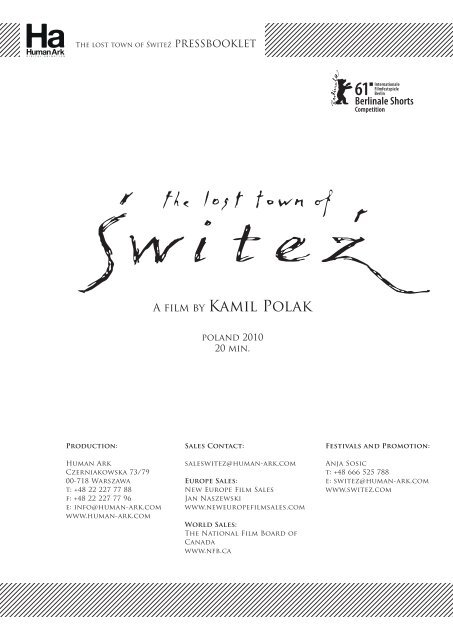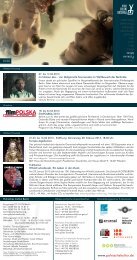A film by Kamil Polak - Polnisches Institut Berlin
A film by Kamil Polak - Polnisches Institut Berlin
A film by Kamil Polak - Polnisches Institut Berlin
Create successful ePaper yourself
Turn your PDF publications into a flip-book with our unique Google optimized e-Paper software.
The lost town of Świteź PRESSBOOKLET<br />
Production:<br />
Human Ark<br />
Czerniakowska 73/79<br />
00-718 Warszawa<br />
t: +48 22 227 77 88<br />
f: +48 22 227 77 96<br />
e: info@human-ark.com<br />
www.human-ark.com<br />
A <strong>film</strong> <strong>by</strong> <strong>Kamil</strong> <strong>Polak</strong><br />
poland 2010<br />
20 min.<br />
Sales Contact:<br />
saleswitez@human-ark.com<br />
Europe Sales:<br />
New Europe Film Sales<br />
Jan Naszewski<br />
www.neweurope<strong>film</strong>sales.com<br />
World Sales:<br />
The National Film Board of<br />
Canada<br />
www.nfb.ca<br />
Festivals and Promotion:<br />
Anja Sosic<br />
t: +48 666 525 788<br />
e: switez@human-ark.com<br />
www.switez.com
The lost town of Świteź PRESSBOOKLET<br />
A CELEBRATION OF THE ROMANTIC SPIRIT<br />
The animated <strong>film</strong> THE LOST TOWN OF ŚWITEŹ is based on the 19th-century epic poem <strong>by</strong> Poland’s<br />
greatest writer, Adam Mickiewicz, about a ghostly town deluged after a bloody massacre in medieval<br />
times, which now lies at the bottom of a remote lake. It is an apocalyptic tale of destruction, religious<br />
miracles and spectral visitations.<br />
The <strong>film</strong> imports oil paintings into digital 3D combined with both CG animation and visual special<br />
effects to create a mesmerizing aesthetic experience, set to a specially-commissioned full choral and<br />
orchestral score. It dramatically merges literature, painting, music and animation.<br />
STORY SYNOPSIS<br />
On a tempestuous night a coach battles through the dark forests of 19th-century Poland. The galloping<br />
horses stare at something in the darkness, the coach loses control and, after a wild ride, it smashes<br />
somewhere deep in the woods. A young traveler emerges from the wreckage, the coachman and the<br />
horses having fallen into a deep sleep. Dazed, he staggers further into the woods. From out of the<br />
darkness ominous shadows emerge at speed: all around him are warriors on dark steeds. They release a<br />
barrage of fiery arrows over his head. He runs for his very life to the edge of a lake, where suddenly all is<br />
stillness. He topples into the lake.<br />
The traveler is transported to a medieval world, where he witnesses the last days of the town of Świteź<br />
which lies at the bottom of the lake after being plundered <strong>by</strong> the ghostly warriors that the traveler saw<br />
in the forest. As the town is set on fire, the townspeople flee into their church, and pray for salvation.<br />
Their prayers are answered <strong>by</strong> a deluge, which engulfs marauders and innocents alike. But the innocents<br />
are transformed into lilies, which to this day cover the entire surface of the lake. The next day our young<br />
traveler, stunned but alive, is pulled out of the lake from amongst the lilies.<br />
2
The lost town of Świteź PRESSBOOKLET<br />
VISUAL STYLE<br />
THE LOST TOWN OF ŚWITEŹ was created in an original combination of 3D animation and classic<br />
animation painted with oil paints. Specially-commissioned large-scale paintings were composited<br />
into a multiple-plane 3D computer generated (CG) environment using state-of-the-art digital<br />
animation and compositing techniques. This unique artistic way creates a quality in itself and an<br />
extraordinary means of expression, which is crucial in animation, where strength of content and<br />
visual form merge into a striking and meaningful fusion.<br />
Two distinct styles of paintings were used: 19th-century Slavonic paintings (such as the work of Józef<br />
Chełmoński and Aleksander Gierymski), which give the illusion of perspective and use a realistic<br />
palette, combined with the much more stylized, brightly-colored and iconic 2D paintings of the<br />
Middle Ages.<br />
The middle part of the <strong>film</strong>, which presents the story of the village called Świteź relates to the<br />
medieval style. All characters are made of flat elements referring to the classic cut-out animation. All<br />
of the works were specially created <strong>by</strong> a team of fine artists using various techniques. The finished<br />
paintings were put into the production computers and split into layers in order to achieve depth and<br />
dynamism. The compositing software then allowed the artists to seamlessly integrate the imported<br />
2D elements with the CG elements, so that they appeared to exist in the same three-dimensional<br />
space.<br />
One of the most difficult artistic effects to create was a visual impression of an image inspired <strong>by</strong><br />
the nineteenth century realistic painting. That is the aesthetics in which the <strong>film</strong> begins and ends.<br />
The main character of the Traveler who mystically arrives to the village and discovers its fascinating<br />
history is always presented in the nineteenth-century-style. In the beginning, the Traveler was a very<br />
3
The lost town of Świteź PRESSBOOKLET<br />
rough and raw 3D character, but after using an innovative tool called Brush Shader developed <strong>by</strong> the<br />
Human Ark team especially for the <strong>film</strong>, it gained a unique look which is both classically beautiful<br />
and intriguingly modern.<br />
In addition to real-life paintings, the ŚWITEŹ team also imported real-life textures, such as textiles,<br />
which were then grafted on to the 3D CG animation to give it a stylized, hyper-real aesthetic. Next,<br />
the lighting and environmental particle effects, such as mist, were added to enhance the mood, look<br />
and depth of the <strong>film</strong>.<br />
The creative interaction of artists and production process has given the <strong>film</strong> an exciting energy and<br />
sense of mystery. By mixing very different techniques, a new quality rare to a CGI production has<br />
been created, making the <strong>film</strong> a dramatic and emotional experience.<br />
MUSIC<br />
From the beginning, THE LOST TOWN OF ŚWITEŹ has been conceived without dialogue - the music<br />
is its voice and delivers the emotional impact of the <strong>film</strong>. As a starting point for composer Irina<br />
Bogdanovich, director <strong>Kamil</strong> <strong>Polak</strong> designed a two-meter-long visual narrative of the rise and fall of<br />
the dramatic action of the <strong>film</strong>, and pasted on references to paintings as the inspiration for particular<br />
scenes. Irina had to compose music which reflected the two periods of the <strong>film</strong>, and which was<br />
suitably epic and mysterious for a tale of destruction, religious miracles and spectral visitations. Her<br />
composition is in the Romantic Russian tradition, to which she brings a modern feel. Also important<br />
to the <strong>film</strong> is choral music in the medieval Eastern Orthodox Church tradition. The score has been<br />
recorded for several of the key sections of the <strong>film</strong> using a full orchestra and choir, which imparts a<br />
very encompassing and epic sound.<br />
ADAM MICKIEWICZ<br />
The National Poet of Poland, the Romantic writer and visionary, Adam Mickiewicz (1798 –1865), is to<br />
the Poles what Homer is to the Greek or Shakespeare to the English. One of the greatest Slavic poets,<br />
Mickiewicz encountered the likes of Goethe, George Sand and Pushkin on his extensive European<br />
travels.<br />
One of his best-known works, the mysterious ballad “Świteź” is suffused with romanticism and poetic<br />
mysticism, demonstrating the rich influence of Polish folk tales and popular beliefs.<br />
Mickiewicz has had a strong and enduring impact on Eastern European thought and creative<br />
imagination, inspiring artists, writers and composers (including Chopin, Tchaikovsky and Rimsky-<br />
Korsakov), and continues to do so to this day. In 2000 the renowned Polish <strong>film</strong>-maker Andrzej Wajda<br />
4
The lost town of Świteź PRESSBOOKLET<br />
<strong>film</strong>ed Mickiewicz’s great epic, “Pan Tadeusz”.<br />
CREATIVE TEAM<br />
KAMIL POLAK<br />
Director <strong>Kamil</strong> <strong>Polak</strong> studied classical music, ballet and painting at the College of Fine Arts in Warsaw,<br />
and excelled in all these disciplines. His love of story-telling brought him to <strong>film</strong>-making, and in<br />
animation he has found the opportunity to combine his classical training in drawing and painting<br />
with his love of music and rhythm, and to bring these together in one dramatic narrative. He studied<br />
directing at the world-renowned Łódź Film School. His <strong>film</strong> “Inside” is on the all-time great <strong>film</strong>s<br />
reel of the School, and his <strong>film</strong> “Birth of a Nation” won the 2nd prize at the Wiesbaden International<br />
Festival and has been widely sold to international television. He developed THE LOST TOWN OF<br />
ŚWITEŹ during his graduation year. <strong>Kamil</strong> was the Visual Effects Supervisor on “Peter & the Wolf”, a £<br />
2.5 million stop-frame animation for Channel 4 and for the big screen accompanied <strong>by</strong> live orchestra<br />
k.polak@human-ark.com<br />
Filmography:<br />
„The Lost Town of Świteź”, 2010, (Director), 20 min<br />
„In”, 2003, (Director), 3min<br />
„Birth of a Nation”, 2001, (Director), 4min<br />
„Splinter”, 2007, (Compositing Artist)<br />
„Peter and the wolf”, 2006, (Visual Effects Supervisor)<br />
„Mokra bajeczka”, 2005, (Visual Effects Supervisor)<br />
„Letter”, 2004, (Animator)<br />
„Dybuk”, 2003, (Video Projection)<br />
„Penguin”, 2002, (Animator)<br />
5
The lost town of Świteź PRESSBOOKLET<br />
Director’s Statement<br />
„At the very beginning there were emotions: anger, happiness, sadness, melancholy, fear and a<br />
sense of being lost when facing the enormity of the universe. All this was accompanied <strong>by</strong> the<br />
hope that good, consolation and happiness in its purest, shapeless form truly exist.<br />
The combination of these words might seem over the top and can make some people feel<br />
unease but for me it is a simplified description of the energy and the state, which I wanted to<br />
share with everybody, while believing in the purifying strength of that energy.<br />
When I accidentally read the ballad „Świteź” <strong>by</strong> Adam Mickiewicz, describing the last day of<br />
existence of a medieval town, where the mysterious lake Świteź lies these days, the same type of<br />
emotions ran through me. I felt that I found a way to channel that state of mind to the outside.<br />
Surprisingly, a romantic text, written almost 200 years ago, became the main inspiration to make<br />
the animated <strong>film</strong> THE LOST TOWN OF ŚWITEŹ.<br />
Together with my team, I started to create this non-existent world. We built landscapes, a wooden<br />
town with a brick church inside it. We animated a XIX century hero, who would experience the<br />
most incredible night in his life, we created choreography for thousands of extras, we controlled<br />
the elements of fire and water so that they would face each other in a battle for human life.<br />
Good against evil. Life against death. The struggle of faith for the purest happiness and inner<br />
peace.<br />
In the visual sphere, I looked up to great painters (Rublow, Gierymski, Szyszkin, Uccello),<br />
<strong>film</strong>makers (Griffith, Eisenstein) and creators of amazing ballet spectacles (Tchaykovsky,<br />
Prokofiev) – that’s why everything in this <strong>film</strong> lives with music.<br />
And although the whole visual word is borrowed, put together from images seen in museums<br />
and present in different cultures, still there is blood flowing through the <strong>film</strong> – it’s the blood of<br />
my emotions and how I experience the world.<br />
Let multiplicity, complexity, rhythm, good, love, happiness, peace and hope win over simplicity,<br />
hopelessness, death, war and evil in this 20 minute animated <strong>film</strong>. And let the catharsis experienced <strong>by</strong><br />
the protagonist when diving in the lake of Świteź be given to every member of the audience.”<br />
<strong>Kamil</strong> <strong>Polak</strong><br />
IRINA BOGDANOVICH<br />
Composer Irina Bogdanovich is a striking new talent from Russia. She graduated with honors from<br />
the Choral Conducting Department at Moscow University and then from the Piano Department at<br />
the University of Yekaterinburg. As a student she twice won the 1st Prize at the Russian National<br />
Student Piano Competition. Currently she is the Conductor and Artistic Director of the Warsaw<br />
University Choir, which won the 3rd Prize in the International Choral Music Festival in Randers. Under<br />
her stewardship the Choir has developed a very high profile. At the 6. ERA New Horizons IFF in<br />
2006 Irina conducted a 60-piece orchestra and 80-person choir to accompany Sergei Prokofiev’s<br />
Alexander Nevsky at an open-air concert performed to an audience of 12,000 in Wrocław.<br />
6
The lost town of Świteź PRESSBOOKLET<br />
PRODUCTION<br />
Delegate producer Human Ark is an Animation Studio based in Warsaw, which specialises in 3D<br />
Animation and Special Effects. It is fast gaining a reputation as one of the most innovative and bestresourced<br />
producers of internationally-coproduced animated features and series. Human Ark has a<br />
strong team of top graphic artists, animators and specialist technicians, all well-versed both in the<br />
rich traditions of Polish animation and in the latest technological advances.<br />
www.human-ark.com<br />
AUDIO POST-PRODUCTION<br />
THE NATIONAL FILM BOARD OF CANADA, which has post-produced the soundtrack for THE LOST<br />
TOWN OF ŚWITEŹ, is the doyen of animated <strong>film</strong> production, having produced over 13,000 <strong>film</strong>s and<br />
won over 5,000 international awards, including 12 Oscars®<br />
www.nfb.ca<br />
SALES AND PROMOTION<br />
International promotion of THE LOST TOWN OF ŚWITEŹ is handled <strong>by</strong> New Europe Film Sales – the<br />
only sales agent in Poland. The company handles world sales of numerous short <strong>film</strong>s (incl. <strong>Berlin</strong>ale<br />
2010 winner “Incident <strong>by</strong> a Bank” <strong>by</strong> Ruben Östlund).<br />
www.neweurope<strong>film</strong>sales.com<br />
7
The lost town of Świteź PRESSBOOKLET<br />
Piotr Dumała about THE LOST TOWN OF ŚWITEŹ<br />
„If Mickiewicz lived today, he could be a <strong>film</strong> maker. The way he describes reality and consequences<br />
of different events is very much fit for a <strong>film</strong>. (…) [Watching ŚWITEŹ] at the very beginning, I am<br />
impressed with the carriage. I can see trees as if they were in a stereoscopic camera. It is a bit like<br />
a childlike joy at seeing something impossible, that all of a sudden someone is sailing in the air,<br />
levitating. This is like watching something through telescopic glasses for the first time, and we can<br />
experience such a WOW effect; something incredible has happened. And this moment when the<br />
carriage is speeding, the camera suddenly stops and we can see that these trees move against each<br />
other, but they do not cease to be flat, yet it is not just a common cut-out, and this is when you feel<br />
delighted. (…) These waves are wet, but they are not just water. They are also a mass of indefinite<br />
matter that performs a kind of a dance around the cathedral before it is ravaged. We do not even<br />
actually see the moment of the ravage itself. It is because it is not about this. It is more of a change<br />
from a realistic and <strong>film</strong> vision to a kind of an ornamental abstraction that transforms in front of our<br />
eyes and is beautiful in itself.”<br />
„It is a new statement in animation that has something from 2D, 3D, painting, computer <strong>film</strong>, but<br />
actually none of these can I discern in this <strong>film</strong> separately. Just like <strong>Kamil</strong> told me that for him this <strong>film</strong><br />
is an experience that the character undergoes, that is purifying, and it would be ideal for him if the<br />
spectator could experience the same, that this <strong>film</strong> is just a kind of immersion into something that<br />
leaves us changed as we go out.”<br />
Piotr Dumała is a Polish <strong>film</strong> director and animator.<br />
The fragments are taken from a statement for a documentary about the making of THE LOST TOWN<br />
OF ŚWITEŹ.<br />
8
The lost town of Świteź PRESSBOOKLET<br />
CREDITS<br />
Production:<br />
Human Ark, Poland<br />
Producers:<br />
Stanisław Dziedzic<br />
Zbigniew Żmudzki<br />
<strong>Kamil</strong> <strong>Polak</strong><br />
Eliza Oczkowska<br />
Co-Producers:<br />
Luc Toutounghi<br />
Denis Friedman<br />
Paweł Partyka<br />
Marcin Łunkiewicz<br />
Co-Production:<br />
Se-Ma-For Produkcja Filmowa, Poland<br />
Archangel SA, Switzerland<br />
Denis Friedman Productions, France<br />
National Film Board of Canada<br />
Telewizja Polska SA, Poland<br />
Państwowa Wyższa Szkoła Filmowa Telewizyjna<br />
i Teatralna im. L. Schillera, Poland<br />
Partyflex System, Denmark<br />
<strong>Kamil</strong> <strong>Polak</strong><br />
Zielony Pomidor, Poland<br />
Executive Producers:<br />
René Chénier<br />
Viviana Queirolo - Bortoglio<br />
Franc Malmin<br />
Neil Mundy<br />
In Association with:<br />
Riforma Film<br />
Film Produkcja<br />
La Cour des Miracles<br />
SBS<br />
ETV<br />
TV Unam<br />
Director:<br />
<strong>Kamil</strong> <strong>Polak</strong><br />
Script:<br />
<strong>Kamil</strong> <strong>Polak</strong><br />
Animation Supervisor:<br />
Wojciech Wawszczyk<br />
Editor:<br />
<strong>Kamil</strong> <strong>Polak</strong><br />
Jacek Rokosz<br />
Alexei Panvilov<br />
Sound:<br />
Luigi Allemano<br />
Music:<br />
Irina Bogdanovich<br />
Film co-financed<br />
<strong>by</strong> the Polish Film <strong>Institut</strong>e<br />
9
The lost town of Świteź PRESSBOOKLET<br />
TECHNICAL INFORMATION<br />
Category:<br />
Short animation <strong>film</strong><br />
Duration<br />
20 min 38 sec (<strong>film</strong> / 24 fps)<br />
19 min 48 sec (video / 25 fps)<br />
Length:<br />
505 m<br />
Picture:<br />
Colour<br />
Format:<br />
Scope 1:2,35<br />
Sound:<br />
Dol<strong>by</strong> Digital 5.1<br />
Completion Date:<br />
December 2010<br />
Available for TV broadcast:<br />
1st March 2011<br />
FOR FURTHER INFORMATION PLEASE CONTACT:<br />
Production:<br />
Human Ark<br />
Czerniakowska 73/79<br />
00-718 Warszawa<br />
t: +48 22 227 77 88<br />
f: +48 22 227 77 96<br />
e: info@human-ark.com<br />
www.human-ark.com<br />
Sales Contact:<br />
saleswitez@human-ark.com<br />
Europe Sales:<br />
New Europe Film Sales<br />
Jan Naszewski<br />
www.neweurope<strong>film</strong>sales.com<br />
World Sales:<br />
The National Film Board of<br />
Canada<br />
www.nfb.ca<br />
Festivals and Promotion:<br />
Anja Sosic<br />
t: +48 666 525 788<br />
e: switez@human-ark.com<br />
www.switez.com<br />
10













